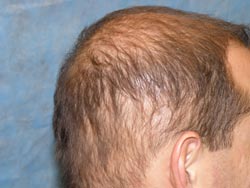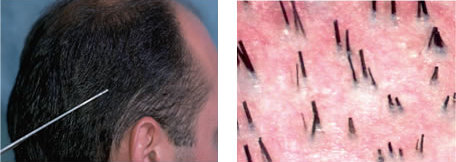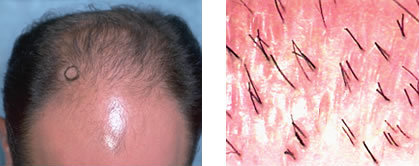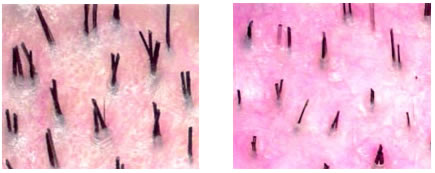What Is “Miniaturization”?
Miniaturization is the hormone-driven biological process in which hairs shrink in size over time, eventually leaving a bald scalp.
The hair follicle growth cycle consists of three phases: a growth phase (“anagen”), a transitional phase (“catagen”), and a resting phase (“telogen”). In genetically-susceptible hair follicles, a hormone called dihydrotestosterone (DHT) can cause the growth phase of the hair cycle to become progressively shorter. The individual hairs produced by these follicles are unable to grow to full size due to this shorter growth window and so they decrease in size (diameter and length) over time until they eventually disappear. This process of “miniaturization” is the main mechanism in androgenetic alopecia (genetic balding).
Normal scalp hair grows in follicular units made up of one to four terminal (full thickness) hairs. The terminal hairs in any single DHT-susceptible follicular unit might be in varying stages of miniaturization, and thus be of varying diameters. When enough terminal hairs are in a state of miniaturization, there appears to be a visible thinning of the hair in the affected areas. As more hairs in each follicular unit become miniaturized, the process may lead to complete baldness in that area of the scalp.
DHT Resistance
In some areas of the scalp, most or all of the follicular units have the genetic predisposition to be immune to the effects of DHT. As a result, these areas might never become miniaturized, and so hair will remain on these parts of the scalp for the person’s entire life. This happens most often in the back and sides of the scalp, aptly known as the “permanent zone,” while the front and top of the scalp are the first areas to experience thinning and baldness.
It is due to this genetic resistance to DHT in the permanent zone that hair transplant surgery can be an effective treatment for hair loss. In a hair transplant, follicular units are removed from the permanent areas of the scalp and implanted into balding areas. Because of a phenomenon known as “donor dominance” these transplanted follicular units retain their DHT-resistance even when transplanted into an area that was formerly populated by hair affected by genetic thinning. Once transplanted, the follicular units will continue to grow normal, non-miniaturized terminal hairs for the lifetime of the individual. Since hairs in the permanent zone provide the donor hairs for use in surgical hair restoration, this region of the scalp is also referred to as the donor area.
Miniaturization in the Donor Area
 A 32 year-old male patient showing diffuse hair loss (DUPA) including miniaturization in the donor area
A 32 year-old male patient showing diffuse hair loss (DUPA) including miniaturization in the donor areaLess commonly, some patients experience miniaturization in the donor area. When a patient’s donor area exhibits miniaturization, it decreases the chances they will be a candidate for a hair transplant. Transplanting hairs that could eventually become miniaturized and disappear negates the cosmetic purpose of a hair restoration procedure. Although miniaturization in the donor area is relatively uncommon in men, it is the norm in women who experience hair loss. This partly explains why fewer women are candidates for surgical hair restoration as compared to men. Only women who have a stable donor area are indicated for hair transplant surgery.
Miniaturization in the donor area is also a significant factor in determining the appropriate age at which a patient is a candidate for hair transplant surgery. In many patients with early hair loss, where extensive hair loss takes place when the patient is in their late teens or early/mid-twenties, it is difficult to impossible for the hair restoration physician to determine if the donor area is, in fact, going to be stable over time, or if it will eventually miniaturize. If a surgeon performs a hair transplant on a young patient whose donor area eventually experiences miniaturization, then the transplant may not have the desired cosmetic effect. Not only that, but the patient will be left with scarring in the donor area from donor hair harvesting without the cosmetic benefit of transplanted permanent hair. That is why at Bernstein Medical, we only recommend hair transplants in patients 25 years old or older.
Counter-acting the Effects of DHT
Since DHT is the main cause of male pattern baldness, why not develop a way to prevent DHT from causing miniaturization? That is exactly what happens with the medication Propecia (finasteride). It blocks the enzyme 5-alpha reductase Type II from converting the hormone testosterone into DHT. With lower levels of DHT in the bloodstream, fewer follicular units are exposed to the miniaturizing effects of DHT, and they continue to produce healthy, thick terminal hairs.
Rogaine, a topical over the counter medication for hair loss, also counter-acts the effects of DHT, but goes about it in a totally different way. DHT shortens the growth phase of the hair cycle, leading to progressively smaller and finer hairs. The active drug in Rogaine, called minoxidil, works by lengthening the growth phase of the hair cycle. The result is fewer follicular units that experience miniaturization.
Examples of Miniaturization
See below for three examples of different intensities of miniaturization: the permanent zone with little to no miniaturization, moderate miniaturization, and extensive miniaturization.
Example 1: The Permanent Zone
In the following patient, we see a close-up of the side of his scalp where the hair is not affected by DHT. We see mostly groups of full-thickness hairs (called terminal hairs) and a few scattered, fine vellous hairs, normally seen in a donor area. The pointer (left) indicates the location on the scalp in the close-up view.

Looking at the image above, you can see that the back and sides of the patient’s scalp (the “permanent zone”) have not succumbed to the effects of DHT due to follicles’ genetically-inherited resistance to DHT in that area of the scalp.
Example 2: Moderate Miniaturization
In the area of thinning (see circle below), we see that most of the hair has been miniaturized, although all of the hair is still present.

The hairs, while still present on the scalp, are so much finer in diameter than the patient’s original hair that they give the visual appearance of thinning.
Example 3: Extensive Miniaturization
In the region that is balding below (circle in the center of the scalp), there is extensive miniaturization and only very little loss of actual hairs. However, due to the dramatic thinning of the hair diameter, there is an appearance of almost complete balding in the area despite the presence of fine hair.

What these examples show is that, particularly in the early stages, the appearance of balding is due to the progressive decrease in hair shaft size caused by the miniaturizing effects of DHT, rather than the actual loss of hair.
This is the reason why hair loss medications, such as Propecia (finasteride) or Rogaine (minoxidil), which can reverse the miniaturization process, work well in early hair loss and why, with early hair loss, a surgical procedure is usually not necessary. If medications fail to restore enough hair, or if a patient chooses not to use medical therapy, then a hair transplant may be considered. Certainly, if an area is completely bald, medications will not re-grow hair and surgery can be considered as a first option.






